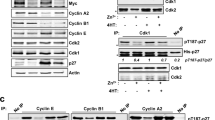Abstract
c-fos and c-jun proto-oncogenes have originally been found in mutated forms in murine and avian oncogenic retroviruses. They both define multigenic families of transcription factors. Both c-jun and c-fos proteins are metabolically unstable. In vivo and in vitro work by various groups suggests that multiple proteolytic machineries, including the lysosomes, the proteasome and the ubiquitous calpains, may participate in the destruction of c-fos and c-jun. The relative contribution of each pathway is far from being known and it cannot be excluded that it varies according to the cell context and/or the physiological conditions. It has been demonstrated that, in certain occurrences, the degradation of both c-fos and c-jun by the proteasome in vivo involves the ubiquitin pathway. However, the possibility that proteasomal degradation can also occur in a manner independent of the E1 enzyme of the ubiquitin cycle remains an open issue.
Similar content being viewed by others
References
Angel P & Herrlich P (1994) in: The FOS and JUN families of transcription factors. CRC Press, Boca Raton, USA
Curran T (1988) In: Reddy EP, Skalka A–M & Curran T (eds) The Oncogene Handbook (pp 307–325) Elsevier, Amsterdam
Piechaczyk M & Blanchard J–M (1994) Critic. Rev. Oncol. Hematol. 17: 93–131
Kruijer W, Cooper JS, Hunter T & Verma IM (1984) Nature 312: 711–716
Müller R, Bravo R, Buckhardt J & Curran T (1984) Nature 312: 716–720
Lamph WW, Wamsley P, Sassone–Corsi P & Verma IM (1988) Nature 334: 629–631
Kovary K & Bravo R (1991a) Molec. Cell. Biol. 11: 2451–2459
Kovary K & Bravo R (1992) Molec. Cell. Biol. 12: 5015–5023
Ryder K & Nathans D (1988) Proc. Natl. Acad. Sci. USA 85: 8464–8467
Ryseck RP, Hirai S–H, Yaniv M & Bravo R (1988) Nature 334: 535–538
Treier M, Staszewsk LM & Bohman D (1994) Cell 78: 787–798
Quantin B & Breatnach R (1988) Nature 334: 538–540
Miao CG & Curran T (1994) Molec. Cell Biol. 14: 4295–4310
Stancovski I, Gonen H, Orian A, Schwartz AL & Ciechanover A (1995) Mol. Cell Biol. 15: 7106–7116
Salvat C, Jariel—Encontre I, Pariat M, Acquaviva C, Robbins I & Piechaczyk M (1997) in: Pandalai SG (ed) Recent development in molecular biology research (in press) Research Signpost, Trivandrum, India
Roux P, Carillo S, Blanchard J—M, Jeanteur P & Piechaczyk M (1994) In: Angel P & Herrlich P (ed) The c—fos and c—jun families of transcription factors (pp 87–93) CRL Press, Bocaraton, Floride, USA
Roux P, Blanchard J—M, Fernandez A, Lamb N, Jeanteur P & Piechaczyk M (1990) Cell 63: 341–351
Coux O, Tanaka K & Goldberg AL (1996) Ann. Rev. Biochem. (in press)
Rivett JA (1993) Biochem. J. 291: 1–10
Peters J—M (1994) Trends Biochem. Sci. 19: 377–382
Kubota S, Duan L, Furuta RA, Hatanaka M & Pomerantz R (1996) J. Virol. 70: 1282–1287
Carillo S, Pariat M, Steff A—M, Roux P, Etienne—Julan M, Lorca T & Piechaczyk M (1994) Oncogene 9: 1679–1689
Croall DE & DeMartino GN (1991) Physiol. Rev. 71: 813–847
Hirai S—I, Kawasaki H, Yaniv M & Susuki K (1991) FEBS Lett. 287: 57–61
Rogers S, Wells R & Rechsteiner M (1986) Science 234: 364–368
Carillo S, Pariat M, Jariel—Encontre I, Steff A—M, Poulat F, Bertha P & Piechaczyk M (1996) Biochem. J. 313: 245–251
Slater ML & Ozer HL (1976) Cell 7: 289–295
Chowdary DR, Bermody JJ, Jha KK & Ozer HL (1994) Mol. Cell Biol. 14: 1997–2003
Kulka RG, Raboy B, Schuster R, Parag HA, Diamond A, Ciechanover A & Marcus M (1988) J. Biol. Chem. 263: 15726–15731
Finley D, Ciechanover A & Varshavsky A (1984) Cell 37: 43–55
Deveraux Q, Wells R & Rechsteiner M (1990) J Biol. Chem. 265: 6323–6329
Jariel—Encontre I, Pariat M, Martin F, Carillo S, Salvat C & Piechaczyk M (1995) J. Biol. Chem. 270: 11623–11627
Hermida—Matsumoto M—L, Chock PB, Curran T & Yang DCH (1996) J. Biol. Chem. 271: 4930–4936
Watt F & Molloy PL (1993) Nucl. Acids Res. 21: 5092–5100
Aniento F, Papavassiliou AG, Knecht E & Roche E (1996) FEBS Lett. 390: 47–52
Fuchs SY, Dolan L, Davis RJ & Ronai Z (1996) Oncogene 13: 1531–1535
Okazaki K & Sagata N (1995) EMBO J. 14: 5048–5059
Papavassiliou AG, Treier M, Chavrier C & Bohman D (1992) Science 258: 1941–1944
Tsurumi C et al (1995) Mol. Cell Biol. 15: 5682–5687
Author information
Authors and Affiliations
Rights and permissions
About this article
Cite this article
Jariel-Encontre, I., Salvat, C., Steff, AM. et al. Complex mechanisms for c-fos and c-jun degradation. Mol Biol Rep 24, 51–56 (1997). https://doi.org/10.1023/A:1006804723722
Issue Date:
DOI: https://doi.org/10.1023/A:1006804723722




